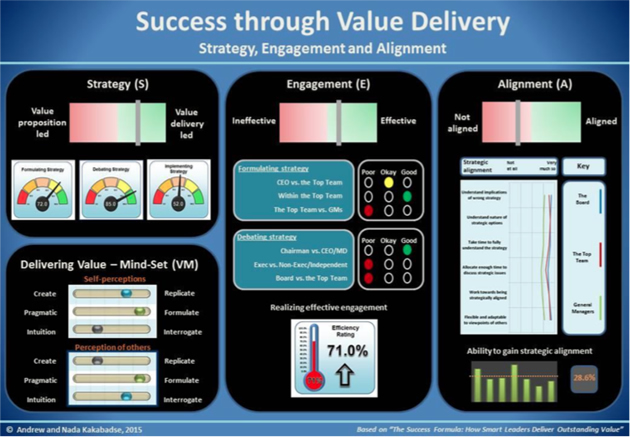Success through Value Delivery
The Success through Value Delivery (SVD) tool was developed based on extensive research across a number of countries, and two different approaches to stakeholder engagement were identified; the value proposition approach and the value delivery led approach. The latter types of organization generally outperform the former.
The SVD tool is a sophisticated instrument that can identify the extent a value delivery culture exists in your organization and its ability to deliver outstanding value to your stakeholders.
Value Proposition vs. Value Delivery
Value propositions are derived from the competitive advantage enjoyed by the organization in attracting customers and maintaining focus. Creating an effective strategy to support the value proposition helps the organization in its market positioning and building. On the other hand value delivery is about continuously ‘proving’ the strategy every day by gathering evidence to test the strategy. Realising sustainable success is about value delivery not value proposition.
Whilst strategy is important, it’s also about strategy execution. The key to long-term success is getting the balance between the reality of engagement and the reality of how people identify with the structure of the organization and the supporting systems. Thus, it’s about the delicate relationship between engagement and alignment to make things happen now versus strategic thinking which aims to shape the future.
Strategic Thinking (S)
The first part of the SVD tool identifies the degree to which an organization is value proposition led or value delivery led. It explores how effective the strategy is in shaping the future in terms of its formulation, the quality of debate and the ability to implement it, for example do those involved:
- Utilize hard rather than soft evidence to support strategy formulation
- Are able to interpret the requirements to develop a robust strategy
- Have the abilities/talents/skills to deliver both in the short and long-term
- Have the ability to make a positive input to the strategic debate
- Instinctively know whether a strategy will work or not
- Have the ability to effectively implement strategy.
Strategic success is about being able to effectively formulate, debate and implement the strategy.
Degree of Alignment (A)
The second part of the SVD tool explores the context within the organization and identifies the degree of strategic alignment across three key groups, namely:
- The Executive Directors
- The Non-Executive/Independent Directors
- General Managers of the organization.
Alignment of thinking requires that the views of each of these three groups are closely positioned. If one or two of these groups are misaligned then there is a ‘faultine’ which could lead to a blockage to effective strategy implementation.
Reality of Engagement (E)
The SVD tool also explores the quality of relationships at each interface within the organization, for example:
- Between the Chairman and the CEO/MD
- Between the Board and the Executive/Management Team
- Between the Executive/Management Team and the General Managers.
Mind-set (VM)
The research found that it’s also about mind-set, which refers to ways of thinking, viewing the world and taking action. How do members of any team, board or group interpret events and processes and from that consider how to act. Such thinking can determine the extent to which individuals or groups consider important in delivering value – which forms the final part of the SVD tool - for example is it about:
- Being able to create or to replicate?
- Being pragmatic or to formulate?
- Using intuition or interrogating?
If views of individuals and groups differ then how important is this in terms of delivering value?
The Dashboard
The dashboard summarizes the key outcomes and the relative positioning of the scores for Strategy, Engagement, Alignment and Delivering Value Mind-set.

If you would like to find out more about how this tool can be used to help your organisation, please contact us.

MOORE RO-MD - An Exclusive Interview with Prof. Andrew Kakabadse and Prof. Nada Kakabadse
Watch video






 @kakabadse
@kakabadse